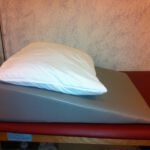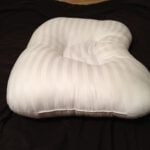 Choosing a Cervical Pillow: 10 Tips to Choose the Best Cervical Pillow
Choosing a Cervical Pillow: 10 Tips to Choose the Best Cervical Pillow
Part 2 of 2
As discussed last week in Part 1 on Cervical Pillows, studies on cervical or neck pillows have shown that those using a cervical pillow demonstrated a significant reduction in chronic neck pain and headaches. However, researchers cautioned that there are many different types of pillows and that—depending on the individual—some may be more effective than others. This week, I offer tips on choosing the best pillow for you.
- Get a Diagnosis – If possible, visit your physician to find out why you have neck pain and headaches. For example, those with arthritis, osteoporosis, degenerative disc disease or other bone and joint problems have great difficulty finding a comfortable position to sleep due to pain, stiffness and headaches upon waking up in the morning. These individuals may see great benefit from using the proper pillow.
- Try it out in the Store – Cervical (or neck) pillows are designed to provide support to the cervical or neck area of the spine. In theory, the pillow attempts to align and support the natural shape of the neck while one is sleeping.
- One Size Does Not Fit All - A traditional pillow is often designed as a one-size-fits-all rectangle that is more about form than function. Imagine that small-framed woman (5 feet tall, weighing 100 pounds) may use the same pillow as a large male football player (6 feet 5 inches, weighing 350 pounds). It is obvious that these two individuals have very different head, neck and shoulder sizes and therefore require two very different pillows.
- Age Matters – People aged 16 to 40 have flexible and hydrated discs and benefit more from a contour pillow with a bump, core or butterfly shape. A thinner pillow that allows the neck to extend and distract while sleeping is helpful. People over age 65 often have arthritic and dehydrated discs with a more rigid spine, and they will benefit more from a thicker pillow with comfortable material such as synthetic down or memory foam which keeps the neck in a slightly elevated and flexed position to avoid hyperextension. People aged 40 to 65 are in between, and they may need to experiment with pillows that allow extension, flexion or neutral positions.
- Special Circumstances – (See Photo of Filled Pillow on Wedge) There are exceptions to every rule. For example, those with allergies should always ask for hypoallergic materials. Those with respiratory conditions or hiatal hernias often require elevation for comfortable sleeping—they may benefit from using an 8-inch to 10-inch wedge and a full pillow, a combination that will elevate the head and chest.
- Standard Filled Pillows – These pillows can be filled with hard or soft materials, such as synthetic or real down, and they resemble a more traditional pillow. They allow for a person to manipulate and shape the pillow according to his or her own liking.
- Memory Foam Pillow - This unique material offers individualized support for almost every body type. However, it is often expensive (although there are now inexpensive versions from lesser-known brands), and it retains heat, which may make it too warm to use in the summer. This type may not be suitable for very small-framed people, as they may not be able to compress the material and will therefore not benefit from its contouring capabilities. (www.tempurpedic.com), (www.thergear.com).
- Contour Pillow – (See photos of Contour Bump Pillow and Contour Core Pillow) These ergonomically designed pillows are contoured to support the “hollow” of the neck with a “bump” or “core.” Some offer a cut out for the side sleeper such as the “butterfly” pillow (See Cervical Pillows - Part I). They work best for younger, more flexible spines and small-framed people. Contour pillows can be found at (www.coreproducts.com), (www.painreliever.com), (www.bodyline.com).
- Travel Pillow – (See photo of Travel Pillow) These pillows offer proper support to prevent your head from bobbing up and down while sleeping in a car or on a airplane. Most are horseshoe collar shaped, and I am partial to the inflatable version from BrookstoneR due to its portability (www.brookstone.com).
- Keep Trying - It is important to remember that there is no one pillow fit for everyone—they are unique to each person. Pillow type should be based on body type, head size, shoulder width, favorite sleeping position, and medical conditions. Always try to sample a cheaper version of a product when possible.
-

-
Filled Pillow on Wedge
-

-
Contour Bump Pillow
-

-
Contour Core Pillow
-

-
Travel Pillow
If you missed Part 1 of this series, you can go back and read it here.
Read “Health & Exercise Forum” in the Scranton Times-Tribune Every Monday. This article is not intended as a substitute for medical treatment. If you have questions related to your medical condition, please contact your family physician. For further inquires related to this topic email: drpmackarey@msn.com.
Paul J. Mackarey PT, DHSc, OCS is a Doctor in Health Sciences specializing in orthopaedic and sports physical therapy. Dr. Mackarey is in private practice in downtown Scranton, PA and is an associate professor of clinical medicine at The Commonwealth Medical College.
 Choosing a Cervical Pillow: 10 Tips to Choose the Best Cervical Pillow
Choosing a Cervical Pillow: 10 Tips to Choose the Best Cervical Pillow